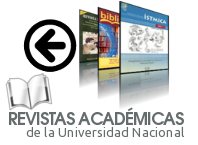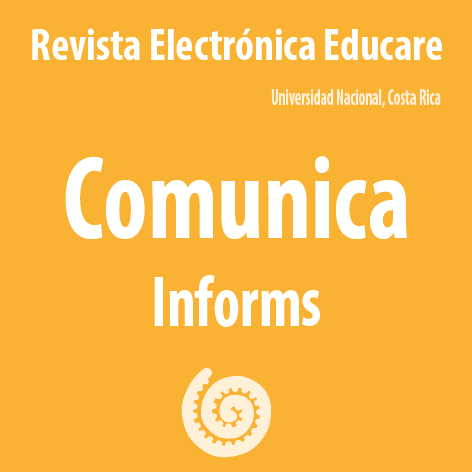Programming Technologies for Social Inclusion With Scratch: Computational Practices in a Teacher’s Professional Development Course
DOI:
https://doi.org/10.15359/ree.23-3.9Keywords:
Computational thinking, Teacher professional development, Scratch, Technologies for Social InclusionAbstract
In recent years, there is an interest in developing practices, concepts and perspectives of computational thinking and programming in schools. Therefore, it is crucial to train teachers in these subjects. However, little is known about the process that teachers follow when approaching these new contents. In this context, the present exploratory and intrinsic case study aims to analyze the computational thinking practices developed by a group of 13 teachers while participating in a professional development workshop, where they created technologies for social inclusion (TIS) by programming with Scratch. The analysis of the different data collected during this pilot experience (surveys, productions carried out by the participants, audio recordings, etc.) evidences a close articulation between computational practices and programming of hypermedia projects that addresse participants’ contextualized problematics. These results show that professional development related to programming was proposed as a process close to the day-to-day reality of teachers, highlighting the importance of generating mediated and situated educational practices. Designing a training path to create TIS appears, in this sense, as a valid option for the teaching of programming and the development of computational thinking, in line with previous studies that proposed professional development courses for teachers from contextualized proposals, and using significant examples in a community and collaborative framework of reflection and exchange.
References
Apiola, M. y Tedre, M. (2012). New perspectives on the pedagogy of programming in a developing country context. Computer Science Education, 22(3), 285-313. https://doi.org/10.1080/08993408.2012.726871
Arranz, H. y Fuente, D. (2017). Evaluación del pensamiento computacional en educación. Revista Interuniversitaria de Investigación en Tecnología Educativa (RIITE), 3, 25-39. Recuperado de https://revistas.um.es/riite/article/view/267411/223391
Balanskat, A. y Engelhardt, K. (2015). Computing our future. Computer programming and coding. Priorities, school curricula and iniciatives across Europe. Brussels, Belgium: European Schoolnet. Recuperado de http://www.eun.org/documents/411753/817341/Computing+our+future_final_2015.pdf/d3780a64-1081-4488-8549-6033200e3c03
Barr, V. y Stephenson, C. (2011). Bringing computational thinking to K-12: What is involved and what is the role of the computer science education community? ACM Inroads, 2(1), 48-54. https://doi.org/10.1145/1929887.1929905
Brackmann, C., Barone, D., Casali, A., Boucinha, R. M. y Muñoz-Hernández, S. (2016). Computational thinking: Panorama of the Americas. En International Symposium on Computers in Education, SIIE 2016: Learning Analytics Technologies (pp. 1-6). Salamanca, España: IEEE. https://doi.org/10.1109/SIIE.2016.7751839
Brennan, K. y Resnick, M. (2012). New frameworks for studying and assessing the development of computational thinking. Ponencia presentada en Annual American Educational Research Association meeting (pp. 1-25). Vancouver, Canadá: AERA. Recuperado de https://web.media.mit.edu/~kbrennan/files/Brennan_Resnick_AERA2012_CT.pdf
Falloon, G. (2015). Building computational thinking through programming in K-6 education: A New Zealand experience. En Proceedings of EDULEARN15 Conference (pp. 0882-0892). Barcelona: IATED. Recuperado de https://researchcommons.waikato.ac.nz/bitstream/handle/10289/9455/Falloon%20full%20paper%20EDULEARN%2715.pdf?sequence=4&isAllowed=y
Gee, J. P. y Green, J. L. (1998). Discourse analysis, learning and social practice: A methodological study. Review of Research in Education, 23, 119-169. doi: https://doi.org/10.2307/1167289
Grover, S. y Pea, R. (2013). Computational Thinking in K–12: A Review of the State of the Field. Educational Researcher, 42(1), 38-43. doi: https://doi.org/10.3102/0013189X12463051
Heintz, F., Mannila, L. y Färnqvist, T. (2016). A review of models for introducing computational thinking, computer science and computing in K-12 education. En Proceedings - Frontiers in Education Conference, FIE. Pennsylvania, USA: IEEE. doi: https://doi.org/10.1109/FIE.2016.7757410
Kafai, Y. B., Searle, K., Kaplan, E., Fields, D. A., Lee, E. y Lui, D. (2013). Cupcake cushions, scooby doo shirts, and soft boomboxes. En Proceeding of the 44th ACM technical symposium on Computer science education - SIGCSE ’13 (pp. 311-316). Denver, Colorado, USA: ACM. https://doi.org/10.1145/2445196.2445291
Lave, J. y Wenger, E. (1991). Situated learning: Legitimate peripherial participation. Cambridge, UK: Cambridge University Press. doi: https://doi.org/10.1017/CBO9780511815355
Lye, S. Y. y Koh, J. H. (2014). Review on teaching and learning of computational thinking through programming: What is next for K-12? Computers in Human Behavior, 41, 51-61. https://doi.org/10.1016/j.chb.2014.09.012
Maloney, J., Resnick, M., Rusk, N., Silverman, B. y Eastmond, E. (2010). The scratch programming language and environment. ACM Transactions on Computing Education, 10(4), 1-15. https://doi.org/10.1145/1868358.1868363
Martínez, M. C. y Echeveste, M. E. (2014). El rol de las comunidades de aprendizaje en la construcción de una visión común para la enseñanza de computación en las escuelas. Revista Iberoamericana de Educación, 65, 19-36. Recuperado de https://rieoei.org/RIE/article/view/391
Menekse, M. (2015). Computer science teacher professional development in the United States: A review of studies published between 2004 and 2014. Computer ScienceEducation, 25(4), 325-350. https://doi.org/10.1080/08993408.2015.1111645
Monjelat, N. (2017). Programming technologies for social inclusion. En A. Diaz, A. Casali, M. C. Rivas, y A. S. Sprock (Eds.), Twelfth Latin American Conference on Learning Technologies (pp. 1-8). La Plata, Buenos Aires: IEEE. doi: 10.1109/LACLO.2017.8120901
Monjelat, N. y San Martín, P. S. (2016). Programar con Scratch en contextos educativos: ¿Asimilar directrices o co-construir tecnologías para la inclusión social? Praxis Educativa, 20(1), 61-71. doi: https://doi.org/10.19137/praxiseducativa-2016-200106
Ohashi, Y. (2017). Preparedness of Japan’s Elementary School Teachers for the Introduction of Computer Programming Education. En V. Dagiene y A. Hellas (Eds.), Informatics in Schools: Focus on Learning Programming. ISSEP 2017. Lecture Notes in Computer Science (Vol 10696, pp. 129-140). Helsinki, Finland: Springer International Publishing. doi: https://doi.org/10.1007/978-3-319-71483-7
Palma, C. A. y Sarmiento, R. E. (2015). Estado del arte sobre experiencias de enseñanza de programación a niños y jóvenes para el mejoramiento de las competencias matemáticas en primaria. Revista Mexicana de Investigación Educativa, 20(65), 607-641. Recuperado de https://www.redalyc.org/pdf/140/14035408013.pdf
Resnick, M. y Brennan, K. (2011). Computational Thinking Practices (ScratchEd Webinar Series). Recuperado de http://scratched.gse.harvard.edu/sites/default/files/april-2011-ct-practices.pdf
Rich, P. J., Jones, B., Belikov, O., Yoshikawa, E. y Perkins, M. (2017). Computing and engineering in elementary school: The effect of year-long training on elementary teacher self-efficacy and beliefs about teaching computing and engineering. International Journal of Computer Science Education in Schools, 1(1), 1-20. doi: https://doi.org/10.21585/ijcses.v1i1.6
Sáez-López, J.-M., Román-González, M. y Vázquez-Cano, E. (2016). Visual programming languages integrated across the curriculum in elementary school: A two year case study using “Scratch’’ in five schools. Computers & Education, 97, 129-141. doi: https://doi.org/10.1016/j.compedu.2016.03.003
Stake, R. E. (1995). The art of case study research. London: Sage.
Thomas, H. (2012). Tecnologías para la inclusión social en América Latina: De las tecnologías apropiadas a los sistemas tecnológicos sociales. Problemas conceptuales y soluciones estratégicas. En H. Thomas, M. Fressoli y G. Santos (Eds.), Tecnología, desarrollo y democracia: Nueve estudios sobre dinámicas sociotécnicas de exclusión/inclusión social (pp. 25-76). Buenos Aires: Ministerio de Ciencia, Tecnología e Innovación Productiva de la Nación.
Vygotsky, L. S. (1978). Mind in society: The development of higher psychological processes. Cambridge, MA: Harvard University Press.
Wing, J. M. (2011). Research Notebook: Computational thinking--what and Why? The link. The magazine of the Carnegie Mellon University School of Computer Science. Recuperado de https://www.cs.cmu.edu/link/research-notebook-computational-thinking-what-and-why
Yadav, A. (2017). Computer science teacher professional development: Towards a research agenda on teacher thinking and learning. En WiPSCE ’17 (pp. 1-2). Nijmegen, Netherlands: ACM Press. doi: https://doi.org/10.1145/3137065.3137066
Yadav, A., Hong, H. y Stephenson, C. (2016). Computational thinking for All: Pedagogical approaches to embedding 21st century problem solving in K-12 classrooms. TechTrends, 60(6), 565-568. https://doi.org/10.1007/s11528-016-0087-7
Yadav, A., Gretter, S., Good, J. y McLean, T. (2017). Computational thinking in teacher education. En P. J. Rich y C. B. Hodges (Eds.), Emerging research, practice, and policy on computational Thinking (pp. 205-220). Cham, Switzerland: Springer International. doi: https://doi.org/10.1007/978-3-319-52691-1
Yin, R. K. (2003). Case study research: Design and methods. London: Sage.
Downloads
Published
How to Cite
Issue
Section
License
1. In case the submitted paper is accepted for publication, the author(s) FREELY, COSTLESS, EXCLUSIVELY AND FOR AN INDEFINITE TERM transfer copyrights and patrimonial rights to Universidad Nacional (UNA, Costa Rica). For more details check the Originality Statement and Copyright Transfer Agreement
2. REUTILIZATION RIGHTS: UNA authorizes authors to use, for any purpose (among them selfarchiving or autoarchiving) and to publish in the Internet in any electronic site, the paper´'s final version, both approved and published (post print), as long as it is done with a non commercial purpose, does not generate derivates without previous consentment and recognizes both publisher's name and authorship.
3. The submission and possible publication of the paper in the Educare Electronic Journal is ruled by the Journal’s editorial policies, the institutional rules of Universidad Nacional and the laws of the Republic of Costa Rica. Additionally, any possible difference of opinion or future dispute shall be settled in accordance with the mechanisms of Alternative Dispute Resolution and the Costa Rican Jurisdiction.
4. In all cases, it is understood that the opinions issued are those of the authors and do not necessarily reflect the position and opinion of Educare, CIDE or Universidad Nacional, Costa Rica. It is also understood that, in the exercise of academic freedom, the authors have carried out a rogorous scientific-academic process of research, reflection and argumentation thar lays within the thematic scope of interest of the Journal.
5. The papers published by Educare Electronic Journal use a Creative Commons License:













 The articles published by Educare Electronic Journal can be shared with a Creative Commons License:
The articles published by Educare Electronic Journal can be shared with a Creative Commons License: 



